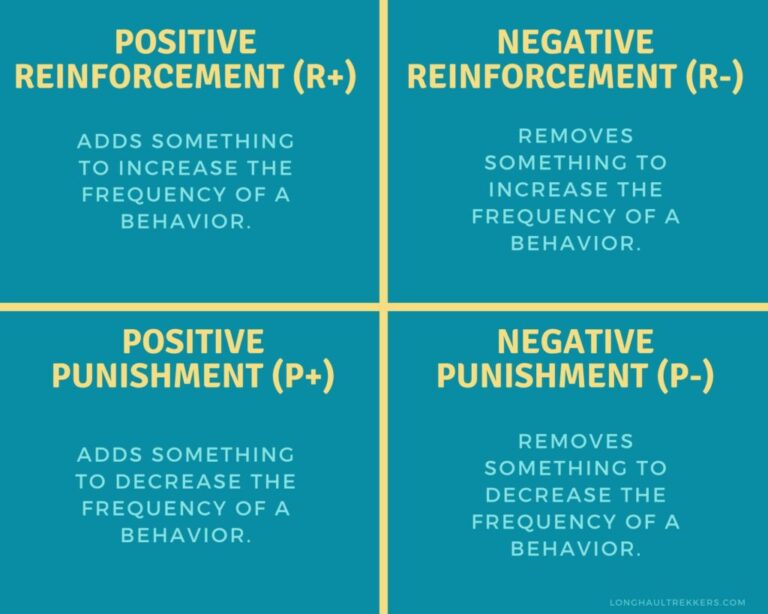Pros And Cons of Positive Reinforcement Dog Training: The Ultimate Guide
Last Updated on April 25, 2024 by Petpalace54
Positive reinforcement dog training is effective in teaching new behaviors & creating enthusiasm for training, but it may not always be reliable in high-pressure situations. While it is a humane and noninvasive method, it can lead to a loss of focus or confusion if not done correctly.
What are the Pros And Cons of Positive Reinforcement Dog Training? The use of treats and rewards can also become a crutch for some dogs, making them less likely to respond without them. Despite its drawbacks, positive reinforcement training has been shown to create a strong bond between the dog & the owner and has long-lasting benefits for behavior modification.
Basically, positive reinforcement dog training has gained popularity over the years as a humane & noninvasive method for teaching dogs new behaviors and modifying their behavior. This method of training is based on rewarding desired behavior with treats or positive reinforcement, such as praise or affection while ignoring unwanted behavior. We will explore the pros and cons of positive reinforcement dog training and how to avoid some of its pitfalls.

Credit: medium.com
Table of Contents
- 1 Pros Of Positive Reinforcement Dog Training
- 2 Cons Of Positive Reinforcement Dog Training
- 3 Alternatives To Positive Reinforcement Dog Training
- 4 How To Implement Positive Reinforcement Dog Training
- 5 Common Mistakes To Avoid In Positive Reinforcement Dog Training
- 6 Frequently Asked Questions On Pros And Cons Of Positive Reinforcement Dog Training
- 7 Final Words
Pros Of Positive Reinforcement Dog Training
Positive reinforcement dog training has numerous benefits, such as building trust and a strong bond between pet and owner, while avoiding the use of physical force or punishment. This method is highly effective for teaching new behaviors and encouraging enthusiasm during training, but may not always be reliable in high-stress situations.
Positive reinforcement dog training involves rewarding desirable behavior with treats, praise, & play instead of punishing unwanted behavior. This approach builds a stronger bond with your dog than punishment-based training techniques. Positive reinforcement’s effectiveness and humane approach have made it a go-to method for many dog owners & trainers. Here are some of the pros of positive reinforcement dog training:
Building A Strong Bond With Your Dog
Positive reinforcement training is based on trust, mutual respect, and communication between you and your dog. When your dog is successful in training, you reinforce trust & build a bond with your dog. You know your dog better than anyone else & training together is a great way to enhance your relationship beyond its current level.
Creating A Positive Learning Environment
Positive reinforcement dog training sets up a positive learning environment that is enjoyable for both you & your dog. Dogs are eager to learn and with a positive approach, the learning process becomes fun, engaging, and rewarding. Dogs are more focused, responsive, and retain the training longer when they have fun while learning.
Effective In Teaching New Behaviors
Positive reinforcement dog training is effective in teaching new behaviors. By using positive reinforcement, dogs are more willing to learn & faster at growing new skills. Positive reinforcement dog training can easily train a dog to do any type of behavior or trick you desire.
Increases Enthusiasm Towards Training
Another pro of positive reinforcement dog training is that it increases enthusiasm towards training. It makes learning a more enjoyable experience for your dog. Dogs become eager about training & continuously seek out new areas to improve their behaviors.
In conclusion, positive reinforcement dog training provides several advantages over the traditional approach. It strengthens the bond between you and your dog, creates a positive learning environment, effectively teaches new behaviors, & increases enthusiasm for training. While there are some cons to using this approach, such as inconsistency, it’s an excellent way to train your furry friend.
Cons Of Positive Reinforcement Dog Training
Possible response: Positive reinforcement dog training has become increasingly popular thanks to its effectiveness & humane approach, but it also has some cons to consider. For instance, some dogs may lose focus during longer training sessions, get frustrated when the task is too challenging, or become confused by unclear signals.
Therefore, it is important to balance positive reinforcement with other training techniques & tailor the approach to each dog’s needs.
ng basic obedience and manners, but may not be effective in correcting severe behavioral issues. There are also a few cons of positive reinforcement dog training that are worth considering before deciding on this training method.
May Not Be Reliable In Emergency Situations
One of the potential cons of positive reinforcement dog training is that it may not be the most reliable method in emergency situations. For example, if your dog is in danger & needs to be recalled immediately, relying solely on positive reinforcement training may not be sufficient. It’s important to have a solid foundation in basic obedience & recall training that your dog can fall back on in high-stress situations.
Not Effective For Correcting Severe Behavioral Problems
While positive reinforcement can be an effective tool for teaching your dog basic obedience & manners, it may not work as effectively for correcting severe behavioral problems. If your dog has aggressive tendencies or is suffering from anxiety, positive reinforcement alone may not be enough to address these underlying issues. In these cases, it may be necessary to explore other training methods or seek the help of a professional dog trainer to get to the root of the problem.
Requires Consistent & Frequent Training
Positive reinforcement dog training requires consistent and frequent training sessions to be effective. If you’re not able to commit to regular training sessions, your dog may not make significant progress. Similarly, if you’re inconsistent in your training methods or timing, your dog may become confused & lose focus, making it more difficult to cement good habits.
May Be Less Effective With Certain Breeds
While positive reinforcement can be an effective training method for many breeds of dogs, it may be less effective with certain breeds that have a more independent or stubborn streak. In these cases, it may be necessary to combine positive reinforcement training with other methods to get the desired results. It’s important to understand your dog’s unique personality & tendencies before deciding on a specific training method.
Overall, positive reinforcement dog training can be a great tool for teaching your dog basic obedience and manners. However, it’s important to be aware of the potential cons of this training method, including its limitations in emergency situations, limitations in correcting severe behavioral problems, the need for consistent and frequent training, & the potential for it to be less effective with certain breeds.
Alternatives To Positive Reinforcement Dog Training
While positive reinforcement is a popular method of dog training, there are alternatives to consider. Some may prefer balanced training, which incorporates both positive & negative reinforcement, while others may opt for aversive training techniques. It’s important to research and weigh the pros and cons of each method before deciding which is best for your dog.
Alternatives to Positive Reinforcement Dog Training
While positive reinforcement training is highly effective in modifying a dog’s behavior, there are alternative training methods that some dog trainers & owners choose to use. Let’s explore these alternatives and the pros and cons of each.
Negative Reinforcement Training
Negative reinforcement training involves using an aversive stimulus such as a shock collar or choke chain to stop an unwanted behavior. This method aims to eliminate the undesired behavior through punishment. However, negative reinforcement training can lead to aggression and anxiety in dogs, as well as damaged trust between a dog & its owner.
Punishment-Based Training
In punishment-based training, aversive methods such as physical punishment or scolding are used to eliminate unwanted behaviors. This method can also damage the relationship between a dog and its owner, as well as cause fear, anxiety, & aggression. Punishment-based training can also lead to increased stress & anxiety in dogs, making them less willing to learn new behaviors.
Dominance-Based Training
Dominance-based training assumes that dogs are pack animals & that the owner must establish dominance to have control over the dog’s behavior. This method involves using physical force and intimidation to establish dominance. However, this outdated method has been discredited by modern research on dog behavior. Using dominance-based training can lead to aggression, fear, & anxiety in dogs.
While there are alternative training methods to positive reinforcement, they can have negative consequences & can lead to damaged relationships between a dog and its owner. Positive reinforcement training not only effectively modifies a dog’s behavior but also enhances the bond between a dog and its owner. As responsible pet owners, it’s crucial to choose training methods that prioritize the well-being & happiness of our furry friends.

Credit: www.amazon.com
How To Implement Positive Reinforcement Dog Training
Pros And Cons of Positive Reinforcement Dog Training involves rewarding good behavior rather than punishing bad behavior, which can result in a more positive experience for both the dog and the owner. Some benefits include building trust & a lasting bond with the dog and avoiding physical force or intimidation.
However, some cons include the potential for the dog to lose focus during longer training sessions or confusion from lack of clear signals.
When it comes to dog training, positive reinforcement is one of the most effective and humane methods available. It involves rewarding your dog for desired behaviors rather than punishing them for undesirable ones. However, implementing positive reinforcement training requires a solid understanding of its principles & some best practices. In this section, we will explore how to implement positive reinforcement dog training through the following subheadings:
Understanding The Principles Of Positive Reinforcement
To implement the Pros And Cons of Positive Reinforcement Dog Training, it is important to understand its principles. Positive reinforcement involves rewarding your dog for performing specific behaviors you want to encourage. The reward can be anything your dog finds rewarding, such as treats, toys, or praise. This method is based on the idea that behavior that is rewarded is more likely to be repeated, thus reinforcing the desired behavior.
Using Treats & Rewards Effectively
One of the most popular ways to provide positive reinforcement is through the use of treats and rewards. It is important to remember that treats and rewards should be used effectively. Treats should be small and easy to eat. Timing is also critical; the reward should be given as soon as the desired behavior is exhibited. Use treats and rewards sparingly, and gradually phase them out as your dog becomes more consistent in their behavior.
Setting Clear & Achievable Goals
To achieve success using positive reinforcement, it is important to set clear and achievable goals. Begin with simple commands & behaviors and gradually increase the difficulty as your dog becomes proficient. Avoid moving too fast, setting unreasonable expectations, or trying to teach too many behaviors at once. This can lead to confusion & make training less effective.
Consistency & Repetition In Training
Consistency and repetition are critical in positive reinforcement training. Consistency provides clarity and reinforces the desired behavior. Repeat your commands regularly to help reinforce the behavior you want. Consistency in training also means using the same commands or gestures every time. This helps your dog understand the desired behavior & respond appropriately.
Finally, implementing positive reinforcement dog training requires patience, consistency, & dedication. Understanding the principles of positive reinforcement, using treats and rewards effectively, setting clear and achievable goals, and maintaining consistency and repetition are key elements in successful dog training. By following these best practices, you can create a happy and well-behaved companion and strengthen the bond between you & your furry friend.
Common Mistakes To Avoid In Positive Reinforcement Dog Training
When it comes to the Pros And Cons of Positive Reinforcement Dog Training, there are some common mistakes that should be avoided. These mistakes include using treats as a bribe, not being consistent with rewards, and not properly reading the dog’s body language. By avoiding these mistakes, positive reinforcement can be an effective & enjoyable training method for both the dog and the trainer.
Common mistakes to avoid in positive reinforcement dog training
Positive reinforcement is a popular dog training method that involves using rewards to encourage good behavior. While this method can be highly effective, it’s important to avoid some common mistakes that can have a negative impact on your dog’s training progress. In this blog post, we’ll explore some of the common mistakes to avoid to ensure your dog’s training remains successful.
Giving treats at the wrong time
One of the most common mistakes that dog owners make in positive reinforcement training is giving treats at the wrong time. Treating your dog too often or outside of training sessions can lead to confusion about what is expected of them. For instance, if your dog jumps on you for attention & you immediately reward them with a treat, it reinforces the wrong behavior. Instead, treats should only be given when your dog exhibits good behavior.
Inconsistency in training
Consistency is key when it comes to positive reinforcement dog training. If you only use positive reinforcement occasionally or inconsistently, your dog may become confused about what is expected of them. Inconsistency can also lead to frustration & slower training progress. Therefore, it’s important to be consistent and maintain a regular training schedule to ensure that your dog remains engaged & motivated.
Relying solely on positive reinforcement
Another mistake to avoid is relying solely on positive reinforcement for all of your dog’s behavior training. While this method can be highly effective, it may not work in all situations. For example, if your dog is displaying aggressive behavior, you may need to use a combination of positive & negative reinforcement to correct the behavior. Therefore, it’s important to understand your dog’s limitations & use the appropriate training method for each situation.
Not understanding your dog’s limitations
Finally, it’s important to understand your dog’s limitations and not push them too hard during training sessions. Each dog is unique and has their own set of limitations & abilities. Training your dog outside of their physical or emotional capacity can lead to frustration and slower progress. Therefore, it’s important to understand your dog’s limitations and ensure that training sessions are tailored to their individual needs.
In conclusion, positive reinforcement can be a highly effective training method for dogs. However, it’s important to avoid common mistakes such as giving treats at the wrong time, inconsistency, relying solely on positive reinforcement, & not understanding your dog’s limitations. By avoiding these mistakes, you can ensure that your dog’s training remains successful & that they can become a well-behaved and happy member of your family.

Credit: pupford.com
Frequently Asked Questions On Pros And Cons Of Positive Reinforcement Dog Training
What Are The Disadvantages Of Positive Reinforcement?
Positive reinforcement can make individuals overconfident, affecting their performance. It may cause a loss of focus during longer training sessions, frustration, & confusion for the dog. Additionally, positive reinforcement may not always be reliable in certain situations.
What Are The Cons Of Positive Reinforcement Training?
Some cons of positive reinforcement training include your dog losing focus during longer training sessions, frustration caused by teaching complex tricks, & confusion when there is a lack of clear signals. Over-rewarding can make dogs too confident in their abilities, which can affect their performance negatively.
However, positive reinforcement is still one of the most effective ways to train dogs & build trust with them.
Do Dogs Learn Better Through Positive Reinforcement?
Yes, dogs learn better through positive reinforcement as it uses rewards for desired behavior, making it a powerful tool for shaping or changing a dog’s behavior. However, some cons of positive reinforcement training include losing focus during longer sessions, confusion from lack of clear signals, & frustration from attempting complex tricks.
It’s important to note that increasing the rate of reinforcement can help if positive reinforcement isn’t initially effective.
When Positive Reinforcement Doesn’t Work For Dogs?
If your dog loses focus during longer training sessions, gets frustrated trying to learn complex tricks, or is confused by a lack of clear signals, positive reinforcement may not work as well. In this case, consider increasing the rate of reinforcement by rewarding your dog for every attempt toward the behavior.
Remember to keep training short & consistent.
Final Words
Overall, positive reinforcement dog training has both pros and cons. The pros include building a strong bond between the dog and its owner, encouraging enthusiasm during training, & using non-physical methods. However, the cons can include losing focus during longer training sessions and confusion from unclear signals.
It’s important to carefully weigh the Pros And Cons of Positive Reinforcement Dog Training & decide what approach is best for both you and your furry friend. Remember that every dog is different, and what works for one may not work for another.






